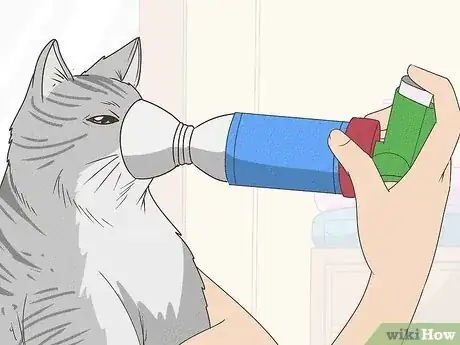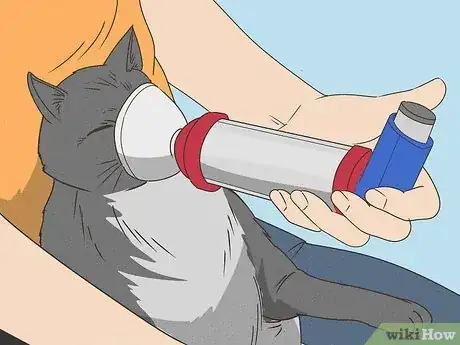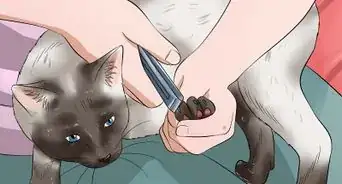This article was co-authored by Natalie Punt, DVM and by wikiHow staff writer, Eric McClure. Dr. Natalie Punt is a Veterinarian and the Founder and CEO of mPet- a smart phone app for pet owners to store, manage and transfer their pets medical records and health information. She specializes in small animal emergency and general medicine and veterinary practice economics. Dr. Punt holds a BS in Biochemistry and Molecular Biology from The University of California, Davis, an MS in Biochemistry from The University at Buffalo, and a DVM from Western University of Health Sciences.
There are 12 references cited in this article, which can be found at the bottom of the page.
wikiHow marks an article as reader-approved once it receives enough positive feedback. In this case, 80% of readers who voted found the article helpful, earning it our reader-approved status.
This article has been viewed 38,660 times.
If your cat has suddenly started wheezing or breathing loudly, you may be wondering if they have feline asthma—a respiratory condition that causes inflammation and spasms in the lungs. While this can understandably be upsetting, rest assured that taking your cat to the vet and getting treatment will dramatically help. Even if your cat does have asthma, it is extremely manageable and there’s no reason your cat can’t live a healthy, full life. In this article, we’ll walk you through everything you need to know about treating a cat with asthma.
Things You Should Know
- If your cat has any kind of difficulty breathing, take them to a vet to have them checked out for feline asthma.
- Feline asthma is typically treated with corticosteroids (usually in the form of an inhaler) and a bronchodilator for emergencies.
- Helping your cat lose weight if they’re obese and keeping your home’s air clean and scent-free will radically improve your cat’s symptoms.
Steps
Expert Q&A
-
QuestionWhat is the life expectancy for cats with asthma?
 Natalie Punt, DVMDr. Natalie Punt is a Veterinarian and the Founder and CEO of mPet- a smart phone app for pet owners to store, manage and transfer their pets medical records and health information. She specializes in small animal emergency and general medicine and veterinary practice economics. Dr. Punt holds a BS in Biochemistry and Molecular Biology from The University of California, Davis, an MS in Biochemistry from The University at Buffalo, and a DVM from Western University of Health Sciences.
Natalie Punt, DVMDr. Natalie Punt is a Veterinarian and the Founder and CEO of mPet- a smart phone app for pet owners to store, manage and transfer their pets medical records and health information. She specializes in small animal emergency and general medicine and veterinary practice economics. Dr. Punt holds a BS in Biochemistry and Molecular Biology from The University of California, Davis, an MS in Biochemistry from The University at Buffalo, and a DVM from Western University of Health Sciences.
Veterinarian It's probably between 14 and 15 years, but it really depends on how severe the asthma is. Other medical conditions (like kidney disease) can also interfere with their overall life expectancy.
It's probably between 14 and 15 years, but it really depends on how severe the asthma is. Other medical conditions (like kidney disease) can also interfere with their overall life expectancy.
Warnings
References
- ↑ https://icatcare.org/advice/asthma-in-cats/
- ↑ https://tvmdl.tamu.edu/2019/06/24/cat-diagnosed-with-feline-asthma/
- ↑ https://pubmed.ncbi.nlm.nih.gov/20800209/
- ↑ https://pubmed.ncbi.nlm.nih.gov/20800209/
- ↑ https://vetmed.tamu.edu/ce/wp-content/uploads/sites/41/2019/07/2019-Feline-Forum-Imaging-Respiratory-Disease-Lab.pdf
- ↑ https://www.vet.cornell.edu/departments-centers-and-institutes/cornell-feline-health-center/health-information/feline-health-topics/feline-asthma-what-you-need-know
- ↑ https://todaysveterinarypractice.com/respiratory-medicine/asthma-in-cats-management-guidelines/
- ↑ https://www.vet.cornell.edu/departments-centers-and-institutes/cornell-feline-health-center/health-information/feline-health-topics/feline-asthma-what-you-need-know
- ↑ https://www.dvm360.com/view/treatment-of-feline-allergic-asthma
- ↑ https://www.aafa.org/control-indoor-allergens/
- ↑ https://icatcare.org/advice/asthma-in-cats/
- ↑ https://www.bluecross.org.uk/advice/cat/caring-for-a-cat-with-asthma
- ↑ https://glencoeanimalhospital.com/2018/08/25/feline-asthma-feline/
- ↑ https://www.bluecross.org.uk/advice/cat/caring-for-a-cat-with-asthma
- ↑ https://www.vetstreet.com/our-pet-experts/why-does-my-cat-snore
- ↑ https://www.trudellanimalhealth.com/learn/further-reading/cat-asthma-symptoms-causes-treatments
- ↑ https://tvmdl.tamu.edu/2019/06/24/cat-diagnosed-with-feline-asthma/
About This Article
To treat a cat with symptoms of asthma, start by taking it to the vet for a diagnosis and the proper treatment. Your vet may recommend treatments such as an oral or inhaled steroid, or a bronchodilator. In addition to giving your cat medication, try to keep your house free from asthma triggers like perfume, hairspray, and cigarette smoke, which can make breathing more difficult. You can also try switching to a dust-free litter to minimize the allergens that affect your cat. For advice from our Veterinary reviewer on how to help your cat if it’s having a severe asthma attack, read on.


































































